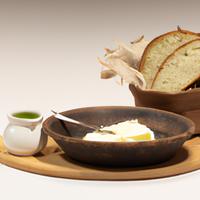
1 serving (43 grams) contains 116 calories, 2.5 grams of protein, 5.5 grams of fat, and 14.5 grams of carbohydrates.

Log this food in SnapCalorie

Nutrition Information
Calories |
637.4 | ||
|---|---|---|---|
% Daily Value* |
|||
| Total Fat | 30.2 g | 38% | |
| Saturated Fat | 19.2 g | 96% | |
| Polyunsaturated Fat | 0 g | ||
| Cholesterol | 54.9 mg | 18% | |
| Sodium | 934.1 mg | 40% | |
| Total Carbohydrates | 79.7 g | 28% | |
| Dietary Fiber | 2.7 g | 9% | |
| Sugars | 8.2 g | ||
| protein | 13.7 g | 27% | |
| Vitamin D | 0 mcg | 0% | |
| Calcium | 219.8 mg | 16% | |
| Iron | 4.4 mg | 24% | |
| Potassium | 219.8 mg | 4% | |
* Percent Daily Values are based on a 2,000 calorie diet. Your daily values may be higher or lower depending on your calorie needs.
Food Attributes
Source of Calories
About Slice of white bread with butter
Slice of white bread with butter is a common snack or side dish found in cuisines worldwide, appreciated for its simplicity and versatility. White bread is typically made from refined wheat flour, water, yeast, and sugar, resulting in a soft texture and mild flavor. Butter, derived from cream, adds richness and a smooth, creamy texture. Nutritionally, white bread is a source of carbohydrates, providing quick energy, while butter contributes fats, including saturated fats, which in moderation are essential for bodily functions. However, white bread has less fiber and fewer nutrients compared to whole-grain options, and excessive saturated fat intake can impact heart health. This pairing is often enjoyed as a comfort food or accompaniment to soups and other dishes, blending accessible ingredients with indulgent taste. Pairing it with whole-grain bread or moderate butter portions can enhance its nutritional profile while maintaining its classic appeal.



